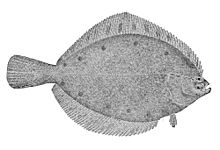
Trawling is an industrial method of fishing that involves pulling a fishing net, which is heavily weighted to keep it on the seafloor, through the water behind one or more boats. The net used for trawling is called a trawl. This principle requires netting bags which are towed through water to catch different species of fishes or sometimes targeted species. Trawls are often called towed gear or dragged gear.
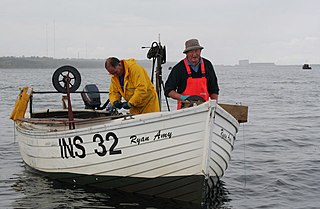
Longline fishing, or longlining, is a commercial fishing angling technique that uses a long main line with baited hooks attached at intervals via short branch lines called snoods or gangions. A snood is attached to the main line using a clip or swivel, with the hook at the other end. Longlines are classified mainly by where they are placed in the water column. This can be at the surface or at the bottom. Lines can also be set by means of an anchor, or left to drift. Hundreds or even thousands of baited hooks can hang from a single line. This can lead to many deaths of different marine species. Longliners – fishing vessels rigged for longlining – commonly target swordfish, tuna, halibut, sablefish and many other species.

Bycatch, in the fishing industry, is a fish or other marine species that is caught unintentionally while fishing for specific species or sizes of wildlife. Bycatch is either the wrong species, the wrong sex, or is undersized or juveniles of the target species. The term "bycatch" is also sometimes used for untargeted catch in other forms of animal harvesting or collecting. Non-marine species that are caught but regarded as generally "undesirable" are referred to as rough fish or coarse fish.

The goal of fisheries management is to produce sustainable biological, environmental and socioeconomic benefits from renewable aquatic resources. Wild fisheries are classified as renewable when the organisms of interest produce an annual biological surplus that with judicious management can be harvested without reducing future productivity. Fishery management employs activities that protect fishery resources so sustainable exploitation is possible, drawing on fisheries science and possibly including the precautionary principle.

Gillnetting is a fishing method that uses gillnets: vertical panels of netting that hang from a line with regularly spaced floaters that hold the line on the surface of the water. The floats are sometimes called "corks" and the line with corks is generally referred to as a "cork line." The line along the bottom of the panels is generally weighted. Traditionally this line has been weighted with lead and may be referred to as "lead line." A gillnet is normally set in a straight line. Gillnets can be characterized by mesh size, as well as colour and type of filament from which they are made. Fish may be caught by gillnets in three ways:
- Wedged – held by the mesh around the body.
- Gilled – held by mesh slipping behind the opercula.
- Tangled – held by teeth, spines, maxillaries, or other protrusions without the body penetrating the mesh.

Lobsters are widely fished around the world for their meat. They are often hard to catch in large numbers, but their large size can make them a profitable catch. Although the majority of the targeted species are tropical, the majority of the global catch is in temperate waters.

The shrimp fishery is a major global industry, with more than 3.4 million tons caught per year, chiefly in Asia. Rates of bycatch are unusually high for shrimp fishing, with the capture of sea turtles being especially contentious.
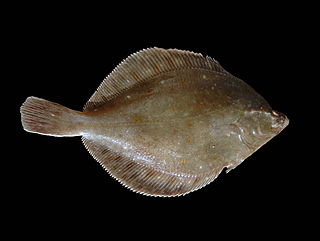
The European plaice, commonly referred to as simply plaice, is a species of marine flatfish in the genus Pleuronectes of the family Pleuronectidae.

Demersal fish, also known as groundfish, live and feed on or near the bottom of seas or lakes. They occupy the sea floors and lake beds, which usually consist of mud, sand, gravel or rocks. In coastal waters, they are found on or near the continental shelf, and in deep waters, they are found on or near the continental slope or along the continental rise. They are not generally found in the deepest waters, such as abyssal depths or on the abyssal plain, but they can be found around seamounts and islands. The word demersal comes from the Latin demergere, which means to sink.

The common dab is an edible flatfish of the family Pleuronectidae. It is a demersal fish native to shallow seas around Northern Europe, in particular the North Sea, where it lives on sandy bottoms down to depths of about 100 metres (330 ft). It can reach 40 centimetres (16 in) in length and can weigh up to 1 kilogram (2.2 lb), though most specimens grow no longer than 20 centimetres (7.9 in).
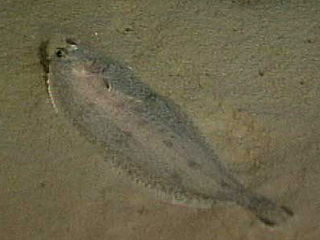
The witch, known in English by a variety of other common names including the witch flounder, pole flounder, craig fluke, Torbay sole, and grey sole, is a species of flatfish from the family Pleuronectidae. It occurs on both sides of the North Atlantic Ocean on muddy sea beds in quite deep water. In northern Europe it has some importance in fisheries as a food fish.

The European flounder is a flatfish of European coastal waters from the White Sea in the north to the Mediterranean and the Black Sea in the south. It has been introduced into the United States and Canada accidentally through transport in ballast water. It is caught and used for human consumption.
Discards are the portion of a catch of fish which is not retained on board during commercial fishing operations and is returned, often dead or dying, to the sea. The practice of discarding is driven by economic and political factors; fish which are discarded are often unmarketable species, individuals which are below minimum landing sizes and catches of species which fishers are not allowed to land, for instance due to quota restrictions. Discards form part of the bycatch of a fishing operation, although bycatch includes marketable species caught unintentionally. Discarding can be highly variable in time and space as a consequence of changing economic, sociological, environmental and biological factors.

The coastline of the Russian Federation is the fourth longest in the world after the coastlines of Canada, Greenland, and Indonesia. The Russian fishing industry has an exclusive economic zone (EEZ) of 7.6 million km2 including access to twelve seas in three oceans, together with the landlocked Caspian Sea and more than two million rivers.
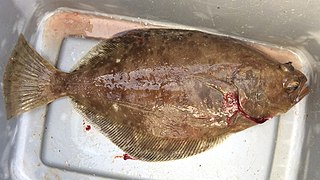
The Petrale sole is an edible flatfish of the family Pleuronectidae. It is a demersal fish that lives on sandy bottoms, usually in deep water, down to depths of about 550 metres (1,800 ft). Males can grow to 53 centimetres (21 in) in length, females to 70 centimetres (28 in), and they can weigh up to 3.7 kilograms (8.2 lb). Its native habitat is the Eastern Pacific, stretching from the coast of Baja California in the south to the Aleutian Islands in the Bering Sea in the north.

Plaice is a common name for a group of flatfish that comprises four species: the European, American, Alaskan and scale-eye plaice.
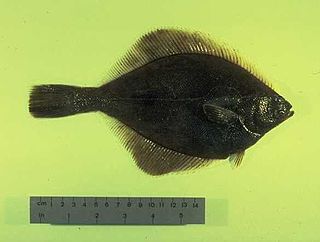
The yellowfin sole is a flatfish of the family Pleuronectidae. It is a demersal fish that lives on soft, sandy bottoms at depths of up to 700 metres (2,300 ft), though it is most commonly found at depths of around 91 metres (299 ft). Its native habitat is the temperate waters of the northern Pacific, from Korea and the Sea of Japan to the Sea of Okhotsk, the Bering Sea and Barkley Sound on the west coast of Canada. Males grow up to 49 cm (19 in) in length, though the common length is around 33.5 cm (13.2 in). The maximum recorded weight is 1.7 kg (3.7 lb), and the maximum recorded lifespan is 26 years.
The North Pacific Fishery Management Council (NPFMC) is one of eight regional councils established by the Magnuson–Stevens Fishery Conservation and Management Act in 1976 to manage the fisheries of the United States. With jurisdiction over the 900,000-square-mile (2,300,000 km2) Exclusive Economic Zone (EEZ) off Alaska, the Council has primary responsibility for groundfish management in the Gulf of Alaska, Bering Sea and Aleutian Islands, including cod, pollock, flatfish, mackerel, sablefish, and rockfish species. Other large Alaska fisheries such as salmon, crab and herring are managed primarily by the State of Alaska.
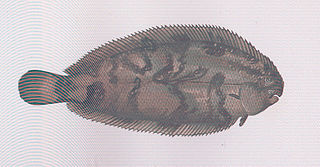
The thickback sole, also known as the bastard sole and lucky sole, is a species of flatfish from the family of true soles, the Soleidae. It is found in the eastern Atlantic Ocean and the Mediterranean Sea, it is a quarry for fisheries in the Mediterranean.

Dorothy Elizabeth Thursby-Pelham (1884–1972) was a scientist at the Zoological Laboratory, University of Cambridge and subsequently at the Ministry of Agriculture, Fisheries and Food - Directorate of Fisheries laboratory in Lowestoft who has been called 'England's first female sea-going fisheries scientist' and was an active member of the International Council for the Exploration of the Sea (ICES).
